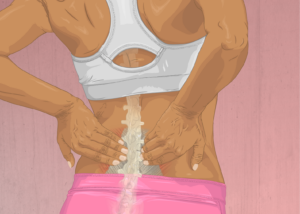
The so-called butt wink in a back squat is bad news and if you have this problem, it needs to be corrected.
Many people butt wink when they perform a squat. Many don’t realize they do this. Why is the butt wink a bad thing?
Well, look at someone doing this. What do you see?
A butt wink is when the lower back loses its extension and morphs into rounding, as the person lowers deeper into the squat.
Some people do the butt wink right before they bottom out, while others experience it a little bit before they reach their depth (whether that’s parallel femurs or deeper).
The butt wink is not deliberate or intentional. It just happens, and there are varying explanations.
How many times have you heard, “Never round the lower back,” when it comes to the squat? Yet, the butt wink is precisely that.
So what’s so bad about a rounded lower back in the squat exercise?
Plenty. The lower back (erector spinae) muscles are stabilizers. They are not force-production muscles.
Their job is to stabilize the spine and transfer forces from the upper body to the lower body, not move heavy weight.
This is why low back injury can result when someone lifts a heavy item off the ground while their lower back is rounded, trunk flexed forward.
The erector spinae are not supposed to absorb forces that the legs and glutes are supposed to absorb.
When a person is at the bottom of a squat, in a butt wink, the erector spinae muscles are absorbing forces that they shouldn’t be, even though the man or woman may not feel this occurring.
When they begin rising out of the squat, the butt will “unwink.” In order for this to happen, the low back muscles must engage before the legs and glutes do.
Once the low back is returned to an extended (arched) position, the legs and glutes can take over.
The risk of low vertebral injury increases as the weight load increases. A “rounded back” during a squat doesn’t always have to resemble the Hunchback of Notre Dame’s.
- Watch someone butt winking.
- It can be quite subtle, but when it’s there, even a half-trained eye can detect it.
- It doesn’t look right, and there’s a reason for that; it’s not right.
Though the increased risk of low back injury is slight if the load isn’t that heavy, who needs strain in this region?
The risk is higher in people who already have tweaky erector spinae muscles.
The butt wink is bad. Make a concerted effort to kick this problem once and for all.









































